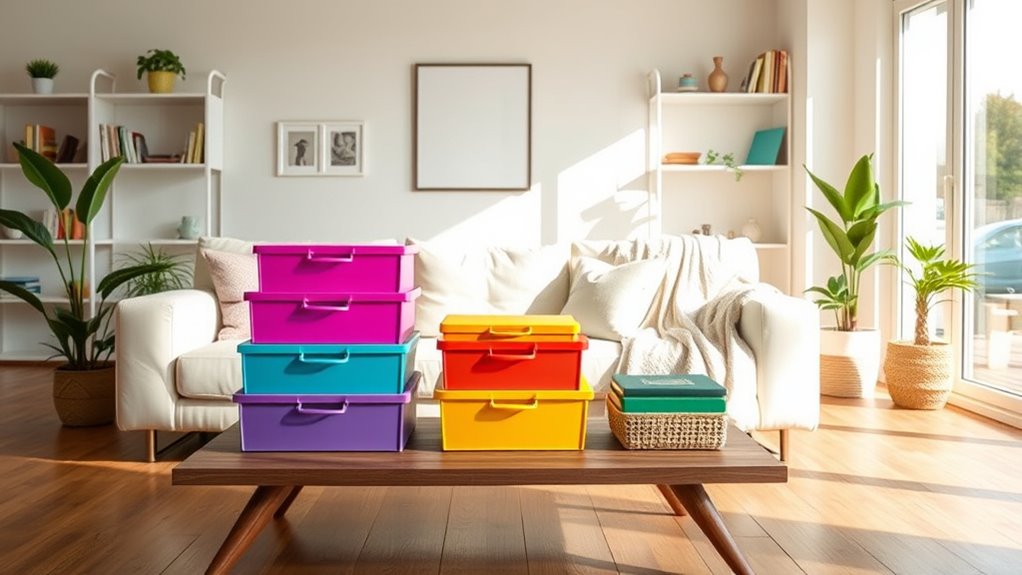To create a weekend decluttering plan you'll actually stick to, start by setting clear goals and assessing your clutter hotspots. Break tasks into smaller, manageable chunks and assign time blocks for each area. Sort items into keep, donate, sell, or trash categories, using containers to stay organized. Incorporate family participation to foster teamwork and maintain momentum. With a little planning and focus, you'll transform your space. Discover more effective strategies for lasting success ahead!
Key Takeaways
- Start with a deep clean to create a fresh slate and motivate decluttering efforts.
- Focus on high-traffic areas first for maximum impact and efficiency in the weekend schedule.
- Break tasks into manageable chunks, tackling one specific area or category at a time.
- Involve family members to share responsibility and create a sense of teamwork during the process.
- Set a visual schedule to track progress and celebrate small victories to maintain motivation.
Setting Your Decluttering Goals

Setting your decluttering goals is crucial for a successful and satisfying experience. Start by reflecting on your motivation—understanding why you want to declutter will keep you focused. Assess the clutter in your space by identifying the most problematic areas and their causes. Prioritize these tasks based on your needs and lifestyle. Creating a vision board can help you visualize your ideal space, making the goal tangible. Break down your overarching goals into specific, manageable tasks using the SMART framework—specific, measurable, achievable, relevant, and time-bound. Focus on one area at a time to avoid feeling overwhelmed, and track your progress. Remember to be flexible; adjust your goals as you move through the process. Additionally, regularly assess your environment for necessary adjustments to ensure continued organization.
Creating a Realistic Schedule
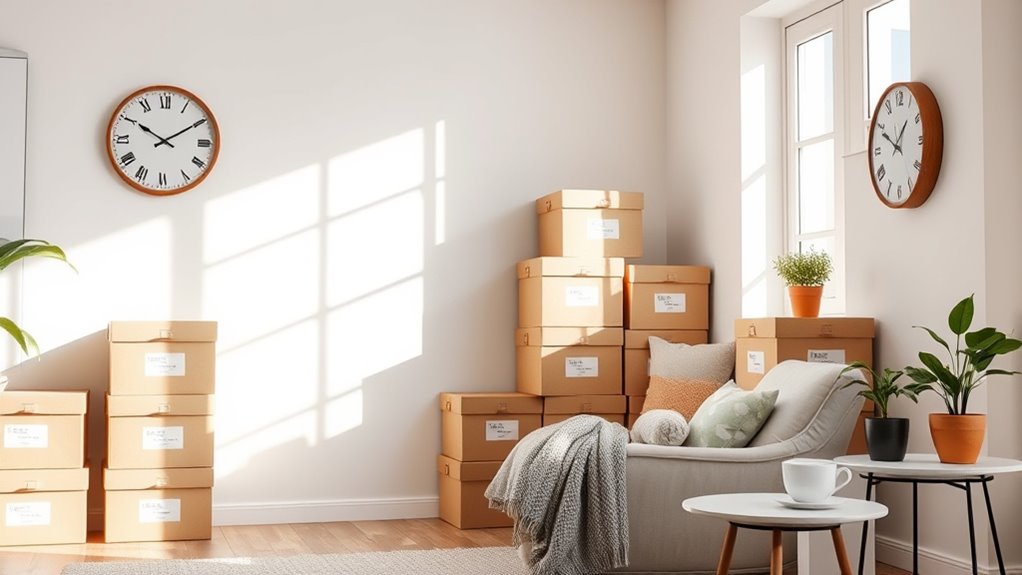
Creating a Realistic Schedule
When you create a realistic decluttering schedule, you're setting yourself up for success. Start with a deep clean to make the decluttering process easier. Focus on high-traffic areas first, as this maximizes efficiency and reduces stress.
Break larger tasks into smaller, manageable chunks to avoid feeling overwhelmed. Decide how often you'll declutter—daily, weekly, or monthly—based on your lifestyle and commitments. Use a visual schedule to track your progress and keep everyone involved.
Analyze your daily routines to find the best times for decluttering, considering your energy levels and possible interruptions. Be realistic about the time you have, and utilize calendars or planners to keep everything organized. This structured approach will make decluttering a breeze! Additionally, organization helps in reducing clutter and creates a home that can be enjoyed year-round.
Identifying Your Clutter Hotspots
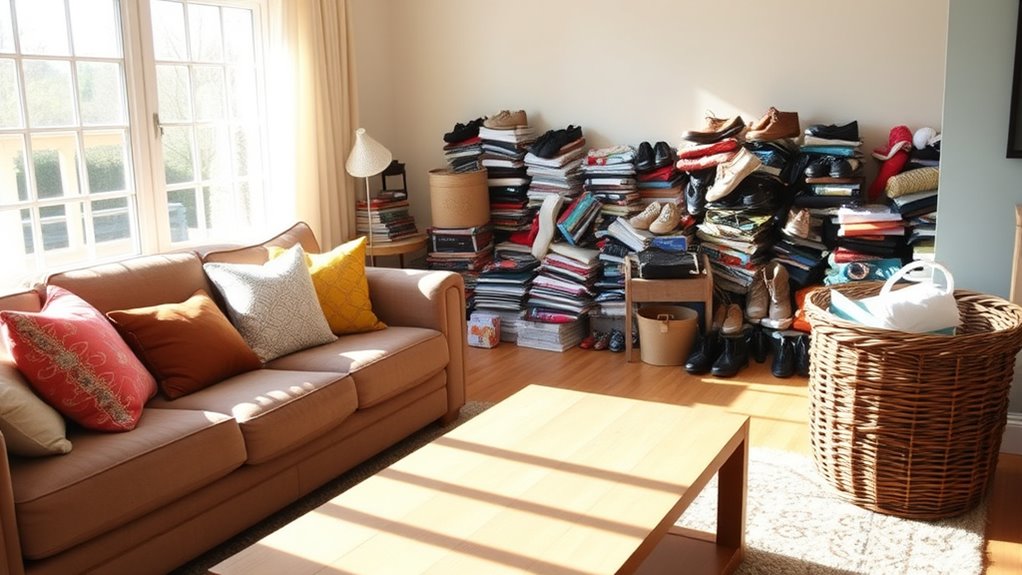
After you've created a realistic decluttering schedule, the next step is to pinpoint your clutter hotspots.
Start by observing common areas like kitchen counters, dining room tables, and entryways—they're often magnets for clutter due to high traffic. Flat surfaces attract items that need a temporary home, while hidden containers can accumulate forgotten clutter. Understanding clutter accumulation helps focus efforts effectively, allowing you to tackle the most problematic areas first. To optimize your home environment, consider conducting a home energy audit which can reveal hidden inefficiencies that may contribute to clutter.
Observe high-traffic areas like counters and entryways; they easily become clutter magnets that need attention.
Pay attention to high-traffic zones where family members frequently pass; these areas can quickly become chaotic.
Also, don't overlook furniture like chairs and sofas, which can turn into clutter catchers for clothes or accessories.
Recognizing these patterns will help you address the root causes of clutter, making your decluttering efforts more effective and sustainable.
Sorting and Organizing Effectively
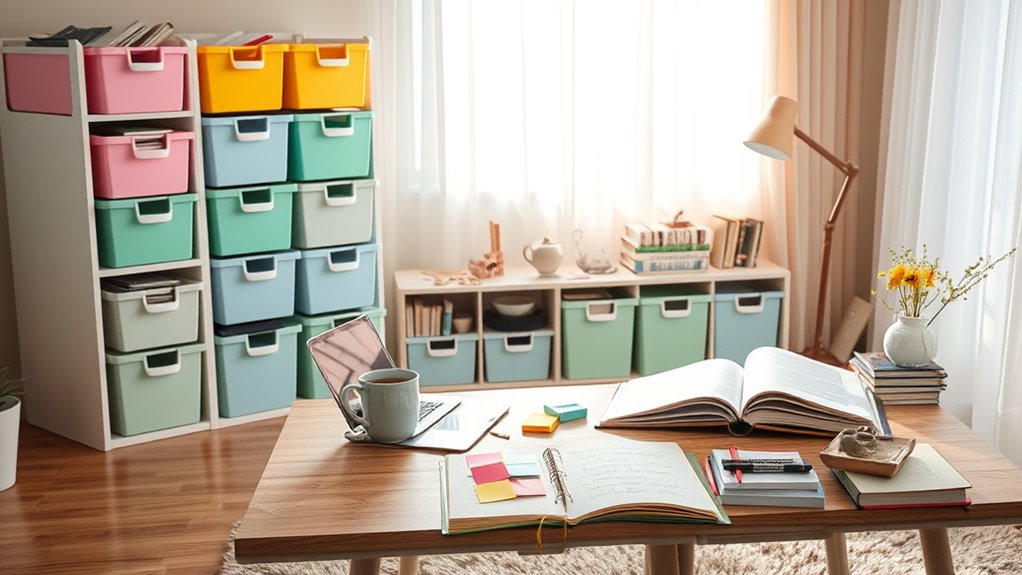
To effectively tackle clutter, you need a clear sorting and organizing strategy that makes the process manageable.
Start by categorizing items into trash, donate, sell, and keep. Use containers to sort items for putting away, fixing, recycling, or tossing.
Try the 12/12/12 Rule: find 12 items to throw away, donate, and return to their rightful spots.
Focus on the 80/20 Rule—if you use 20% of your belongings most often, consider storing or removing the rest. Understanding individual clutter thresholds can help you gauge what to keep and what to let go. Implementing designated zones for specific activities or items can also streamline your organization process.
Organize room by room, or use the Ski-Slope Method to zig-zag through spaces.
Ensure every item has a home and practice the "something in, something out" policy to maintain order.
These strategies will help you declutter efficiently and effectively.
Time Management Tips for Success
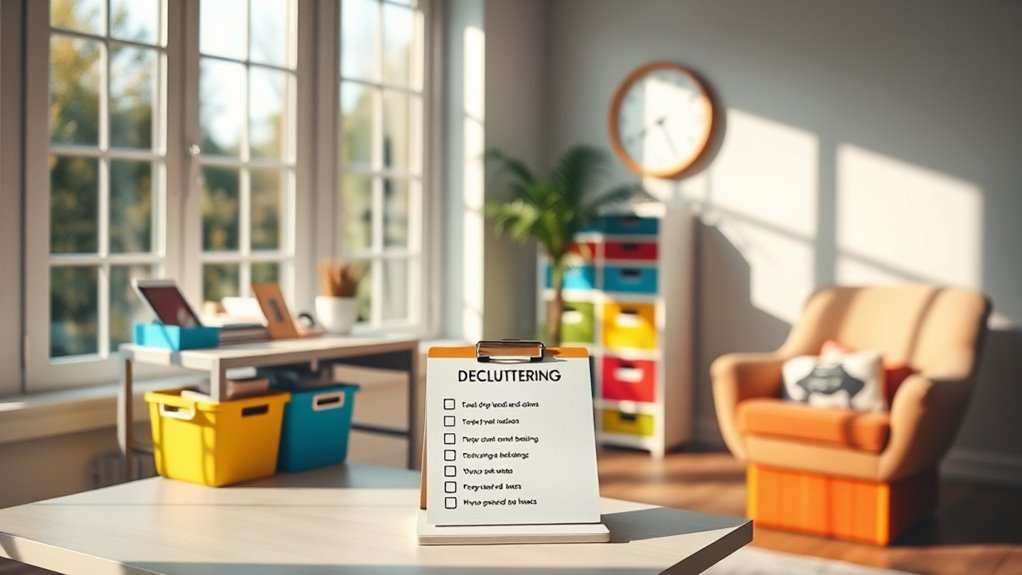
Effective time management can significantly enhance your decluttering experience, allowing you to make steady progress without feeling overwhelmed.
Start by setting clear goals; knowing what you want to achieve keeps you focused. Prioritize tasks to tackle the most important areas first, maximizing productivity. Use a schedule to organize your time and keep everything on track. Implementing strong communication skills can help you articulate your decluttering goals to others, increasing accountability.
Avoid overcommitting; be realistic about what you can accomplish to prevent burnout. Remove non-essential tasks and batch similar ones together for efficiency. Allocate specific time blocks for each task to maintain focus and limit distractions. Remove fluff from your schedule to ensure that your time is dedicated to what truly matters.
Lastly, take regular breaks to recharge and review your progress to adjust your plan as needed. This structured approach will help you stay motivated and efficient throughout your decluttering journey.
Action Steps for a Productive Weekend

With your time management strategies in place, it's time to focus on actionable steps for a productive weekend of decluttering.
Start by listing all the rooms you want to tackle and estimate the time needed for each. Create a decluttering schedule that includes time blocks and breaks. Gather essential supplies like trash bags, donation boxes, timers, and labeling materials. Regular decluttering can help maintain a tidy living environment, making future organizing tasks easier.
As you begin, sort items into categories: trash, sell, donate, store, and a "veto" box for family members. Execute your plan room by room, using timers to stay focused and on track.
At the end of each day, review your progress and adjust the plan if needed. This structured approach sets you up for a successful decluttering weekend.
Maintaining Your Clutter-Free Space

Maintaining a clutter-free space requires intentional habits and consistent effort, so integrating simple strategies into your daily routine can make a significant difference.
Start by adopting the One-In, One-Out rule; for every new item you bring home, let go of an old one.
Embrace the One-In, One-Out rule to effortlessly maintain a clutter-free home by letting go of an old item for every new one.
Schedule regular decluttering sessions, focusing on one area at a time to prevent accumulation. Regular decluttering is essential to avoid overwhelming tasks in the future. Additionally, consider the importance of sustainable building practices when evaluating larger decluttering projects, especially in a tiny house context.
Create designated spaces for your belongings, making them easy to access and return items promptly.
Implement a cleaning routine to keep dirt at bay and spot clutter quickly.
Embrace minimalism by prioritizing quality over quantity.
Lastly, involve your family in maintaining this lifestyle, ensuring everyone contributes to a harmonious, clutter-free home.
Frequently Asked Questions
What if I Feel Overwhelmed by the Decluttering Process?
If you feel overwhelmed by the decluttering process, start small. Focus on one area at a time instead of tackling everything at once.
Use the 4-box method to simplify decisions: keep, donate, trash, and relocate. Set a timer for short sessions to maintain your momentum.
Remember to remove obvious trash first to make a visible difference. Celebrate each small victory to keep yourself motivated throughout the journey.
You can do this!
How Can I Involve Children in Decluttering?
To involve your children in decluttering, make it a fun family activity.
Turn it into a game, set challenges, or create a pretend "toy store" where they can choose what to keep.
Lead by example and declutter your own belongings first.
Use daily short sessions to keep it manageable.
Explain the benefits of decluttering, and praise their efforts to encourage participation.
Together, you'll create a more organized and enjoyable home environment.
What Should I Do With Sentimental Items?
When dealing with sentimental items, start by gathering everything in one place.
Take time to evaluate their emotional significance and consider taking photos to preserve memories. You can share the stories behind each item, which helps in letting go.
Set clear boundaries on what to keep, and think about donating items to others who might appreciate them.
How Often Should I Declutter My Space?
"Out of sight, out of mind" isn't always true when it comes to clutter. You should aim to declutter your space regularly, ideally every few months.
Short, consistent sessions help you maintain a peaceful environment and prevent overwhelming chaos. If that feels daunting, try breaking it into smaller tasks. Remember, even five or ten minutes can make a difference.
Regularly decluttering not only boosts your focus but also enhances your overall well-being.
Can Decluttering Improve My Mental Health?
Yes, decluttering can significantly improve your mental health.
By creating a tidy environment, you reduce visual distractions and lower stress levels. A clutter-free space promotes relaxation, boosts your mood, and enhances productivity.
You'll feel a sense of accomplishment as you organize, leading to clearer thinking and improved decision-making.
Plus, a neat environment can even enhance your cognitive function, fostering creativity and better problem-solving skills, all contributing to a healthier mindset.
Conclusion
By tackling your clutter this weekend, you're not just creating a cleaner space; you're boosting your mental clarity, too. Did you know that a staggering 54% of people feel overwhelmed by their clutter? With your realistic schedule and targeted action steps, you can beat the odds. Stay focused and take pride in each small victory. Remember, maintaining your clutter-free space is just as important as the decluttering process itself. You've got this!
